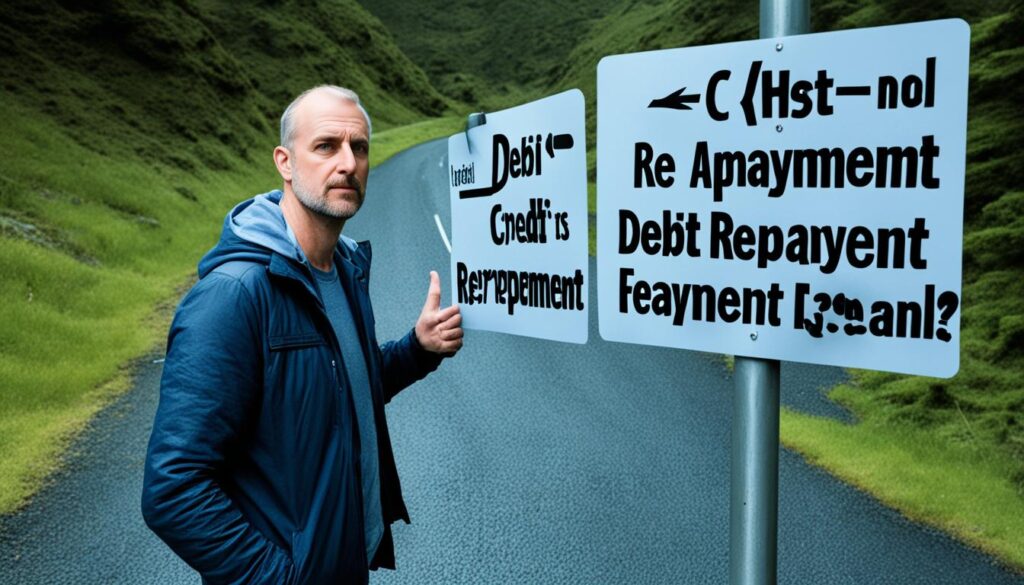Financial stability is a goal that many of us strive for. We work hard, save diligently, and make responsible financial decisions. However, life can throw unexpected curveballs our way, leading to times of economic hardship. During these challenging periods, managing and repaying debts can feel overwhelming and even impossible.
Let me tell you a story about Lisa, a hardworking individual who found herself navigating debt repayment during an economic downturn. Lisa had always been financially responsible, diligently paying off her student loans and credit card debts. She had built a good credit score and was proud of the progress she had made towards financial stability.
However, when the economy took a turn for the worse, Lisa’s employer downsized, and she found herself facing a pay cut and increased financial uncertainty. Suddenly, the debts that Lisa had been managing effectively became a source of stress and anxiety.
With determination and a commitment to overcoming financial challenges, Lisa developed a plan to navigate debt repayment during the economic hardship. She researched various strategies, sought advice from financial experts, and prioritized her financial goals.
With each payment she made, Lisa felt a sense of empowerment and control over her financial situation. She implemented strategies such as building an emergency fund, utilizing the avalanche method to tackle high-interest debts first, and communicating with her creditors to explore hardship concessions.
Through her efforts and perseverance, Lisa was able to navigate debt repayment during the economic downturn successfully. As the economy gradually recovered, Lisa found herself in a better financial position, with a renewed sense of confidence and stability.
Financial hardships can happen to anyone, and navigating debt repayment during these times requires resilience and strategic planning. By learning from Lisa’s story and implementing proven strategies, individuals can effectively manage their debts and achieve financial stability, even during tough economic times.
Key Takeaways:
- Financial stability can be achieved through effective debt management even during economic hardship.
- Building an emergency fund and prioritizing debt repayment are crucial strategies to navigate economic downturns.
- Utilizing the avalanche method and communicating with creditors can help save money and explore hardship concessions.
- It is possible to overcome financial challenges and thrive by staying proactive and making informed decisions.
- With perseverance and dedication, individuals can master their debts and achieve financial stability even during an economic crisis.
Understanding the Financial Mechanics and Principles of Debt Cycles
In order to effectively navigate debt repayment during economic hardship, it is essential to have a solid understanding of the underlying mechanics and principles of debt cycles. This knowledge can provide valuable insights and strategies for dealing with debt crises and economic downturns.
Renowned investor and author Ray Dalio explores these concepts in his book, “Principles for Navigating Big Debt Crises.” In this comprehensive guide, Dalio outlines the intricate relationship between money, credit, debt, markets, and economic cycles. By studying these interconnected elements, individuals can gain a deeper understanding of how debt cycles impact their financial well-being.
By examining historical patterns and drawing from real-world examples, Dalio’s book presents principles for navigating debt crises effectively. These principles offer guidance on how to manage debt, make informed financial decisions, and mitigate potential risks during challenging economic times.
“Understanding the mechanics of debt cycles is crucial for individuals looking to navigate debt repayment during economic downturns. Ray Dalio’s book provides invaluable insights and principles for dealing with debt crises and achieving financial stability.”
Key Principles for Navigating Debt Crises:
- Recognize the stages of a debt cycle and understand their implications.
- Anticipate potential risks and adjust your financial strategies accordingly.
- Diversify your assets and sources of income to minimize vulnerability.
- Stay updated with economic and market trends to make informed decisions.
- Maintain a long-term perspective and avoid making impulsive financial moves.
By grasping the fundamentals of debt cycles and incorporating these principles into your financial planning, you can better navigate the challenges of debt repayment during economic hardship. Developing a comprehensive understanding of the complex interplay between money, credit, debt, and markets empowers individuals to make sound financial decisions and secure their financial future.
“Understanding debt cycles is like having a compass in navigating financial challenges. It equips individuals with the knowledge needed to make informed decisions and stay on course towards debt repayment and financial stability.”
Visualizing the patterns and dynamics of debt cycles can provide further insight into their mechanics and help individuals make sense of the complex relationships between different economic factors. The image above illustrates a simplified representation of debt cycles, emphasizing the cyclic nature of debt accumulation and repayment.
By delving into the principles of debt cycles and gaining a deeper understanding of their mechanics, individuals can navigate debt repayment during economic hardships with greater confidence and effectiveness.
Strategies for Paying Off Debt During Economic Hardship
When facing economic hardship, it is crucial to have strategies in place for paying off debt. One important step is to build an emergency fund that can cover three to six months of living expenses. This provides a financial safety net in case of unexpected job loss or other financial challenges.
Additionally, individuals should prioritize debt repayment, starting with high-interest debts first. Using methods like the avalanche method, where the debt with the highest interest rate is targeted first, can help save money on interest charges.
It is also important to communicate with creditors and ask for hardship concessions if needed. By proactively managing debt and exploring available options, individuals can make progress towards financial stability even during tough economic times.

The Importance of Credit and Debt Management in a Struggling Economy
In a struggling economy, effective credit and debt management play a crucial role in maintaining financial stability. With the possibility of decreased income and limited access to new credit, it becomes even more important to manage existing credit responsibly. By prioritizing debt repayment and making timely payments, individuals can not only protect their credit score but also mitigate the risks associated with mounting debt.
Credit management during economic downturns requires a proactive approach to financial well-being. Here are some key strategies to navigate debt in a struggling economy:
- Prioritize Debt Repayment: Make debt repayment a top priority by allocating as much of your resources as possible towards reducing your outstanding debt. By focusing on paying off high-interest debts first, you can save money on interest charges and accelerate your progress towards financial freedom.
- Make Minimum Payments on Time: While it may be tempting to skip or delay payments, always strive to make the minimum payments on time. This not only avoids late payment fees but also helps maintain a good credit score, which is essential for future financial opportunities.
- Exercise Caution with New Debt: In a struggling economy, it’s essential to carefully consider the implications of taking on new debt. Evaluate the interest rates, terms, and your ability to repay before committing to additional financial obligations.
- Communicate with Creditors: If you’re facing financial difficulties, don’t hesitate to reach out to your creditors and explain your situation. They may be willing to offer hardship programs or payment plans to help you manage your debt during tough times.
By being proactive and strategic in managing credit and debt, individuals can navigate the challenges of a struggling economy and maintain financial stability. Remember, responsible credit management during economic downturns is crucial for long-term financial well-being.

How Can Students Navigate Debt Repayment During Economic Hardship?
During economic hardship, students can benefit from learning about effective student debt repayment strategies. By creating a realistic budget, seeking income-driven repayment plans, and understanding their loan forgiveness options, students can navigate debt repayment with more confidence and financial stability.
How Can I Manage Debt Repayment During Economic Hardship?
During economic hardship, managing debt repayment can be overwhelming. To stay on track, create a budget, prioritize debts, and negotiate payment plans. Use tools for tracking debt repayment progress to monitor your efforts. Seek financial counseling and consider debt consolidation or refinancing options to ease the burden.
Conclusion
Navigating debt repayment during economic hardship can be challenging, but with the right strategies and mindset, individuals can achieve financial stability. By understanding the mechanics of debt cycles, implementing effective debt management strategies, and prioritizing credit and debt management, individuals can overcome financial challenges and thrive even in tough economic times.
One key aspect is to stay proactive in managing debts and communicate with creditors. By keeping them informed about financial difficulties, individuals may be able to negotiate hardship concessions or alternative payment arrangements. It is also important to make informed decisions when it comes to debt repayment strategies, such as prioritizing high-interest debts and exploring debt relief options if necessary.
During an economic downturn, maintaining financial stability is crucial. This includes prioritizing credit and debt management to protect credit scores and overall financial health. Being cautious of taking on new debts and managing existing credit responsibly can help individuals navigate the challenges of a struggling economy.
Remember, with perseverance and dedication, it is possible to master debts and achieve financial stability even during an economic crisis. By staying proactive, communicating with creditors, and making informed decisions, individuals can successfully navigate debt repayment during economic hardship and pave the way for a more stable financial future.
FAQ
What can I do to manage and repay my debts during economic hardship?
To manage and repay debts during economic hardship, it is important to prioritize debt repayment, build an emergency fund, and communicate with creditors for hardship concessions. Implementing effective debt management strategies, such as the avalanche method, can also help save money on interest charges.
How can I navigate debt repayment during an economic downturn?
To navigate debt repayment during an economic downturn, it is important to stay proactive and make informed decisions. Understanding the underlying mechanics of debt cycles and implementing proven strategies for paying off debt can help individuals achieve financial stability even in tough economic times.
What are some strategies for paying off debt during economic hardship?
Some strategies for paying off debt during economic hardship include prioritizing debt repayment, building an emergency fund, and communicating with creditors for hardship concessions. It is also important to explore debt relief options and make informed decisions regarding credit and new debt.
Why is credit and debt management important in a struggling economy?
Credit and debt management become even more crucial in a struggling economy due to limited access to new credit and the possibility of decreased income. By managing existing credit responsibly, making at least minimum payments on time, and prioritizing debt repayment, individuals can maintain good credit scores and navigate the challenges of a struggling economy.
How can I achieve financial stability during economic difficulties?
Achieving financial stability during economic difficulties requires implementing effective debt management strategies, prioritizing debt repayment, and maintaining good credit and debt management habits. By staying proactive, communicating with creditors, and making informed decisions, individuals can overcome financial challenges and achieve stability even in tough economic times.
Source Links
- https://www.linkedin.com/pulse/two-part-look-1-principles-navigating-big-debt-crises-ray-dalio
- https://www.cnbc.com/select/why-financial-experts-suggest-paying-down-debt-before-a-recession/
- https://www.equifax.com/personal/education/personal-finance/articles/-/learn/five-ways-to-prepare-for-a-recession/

